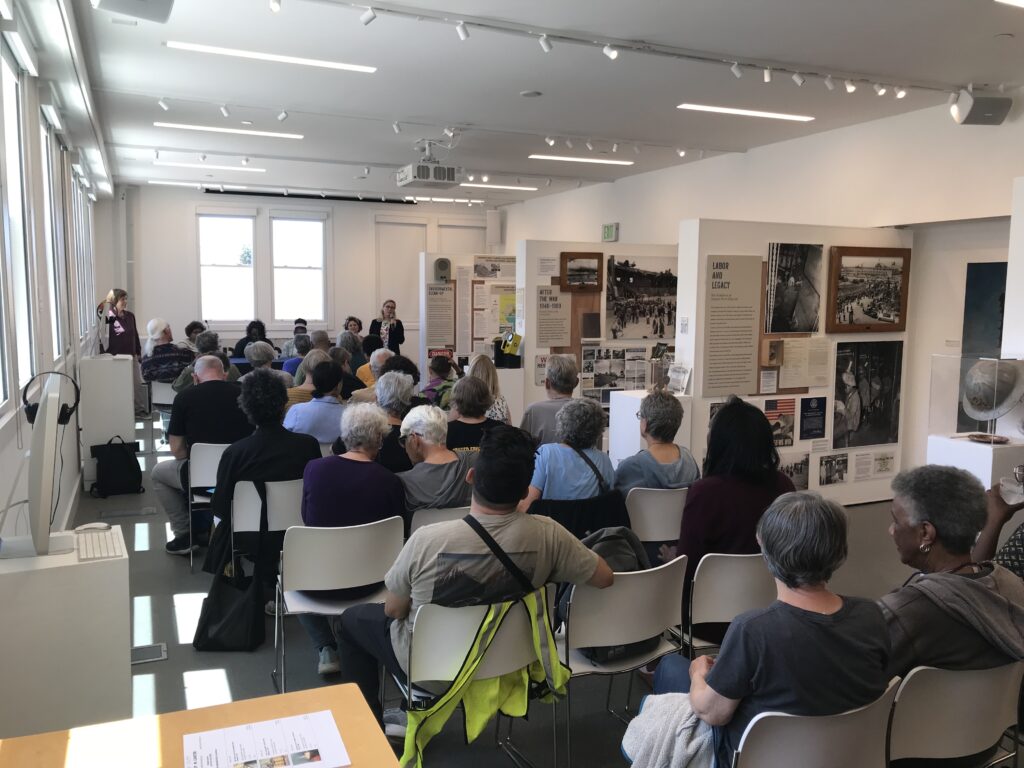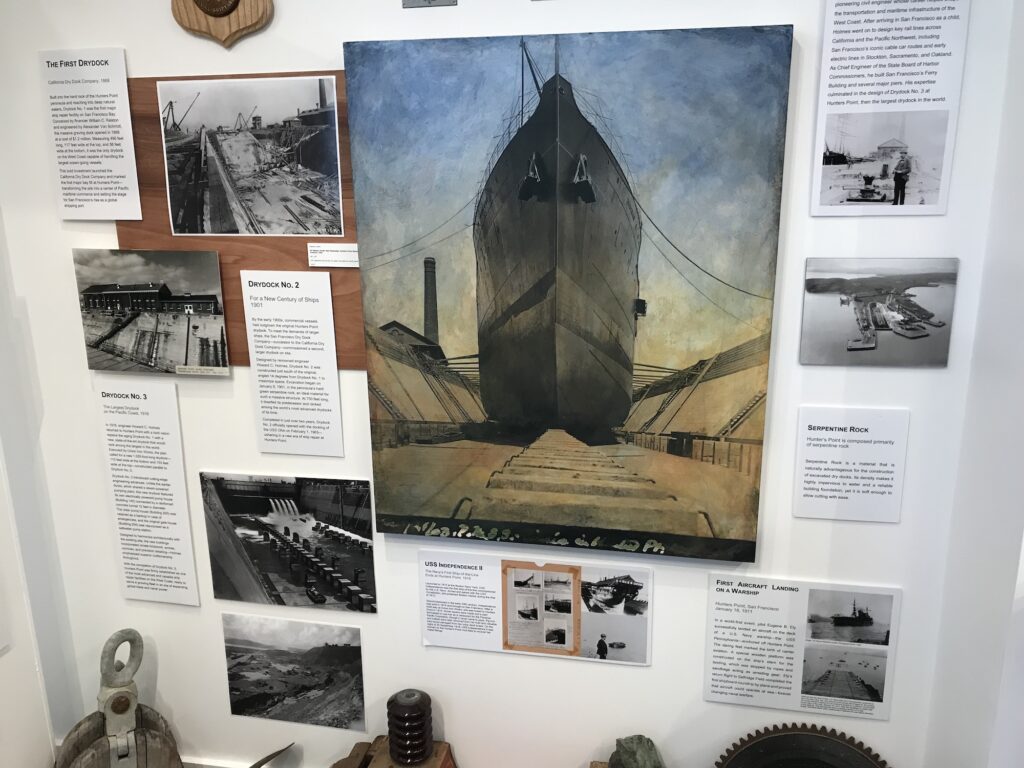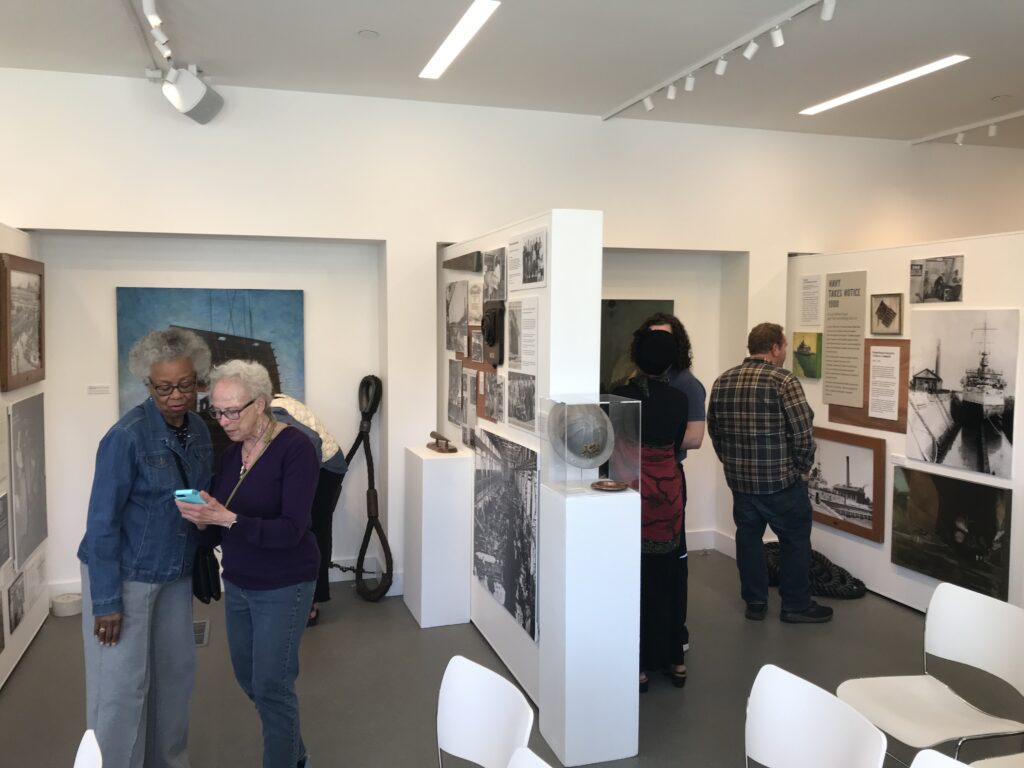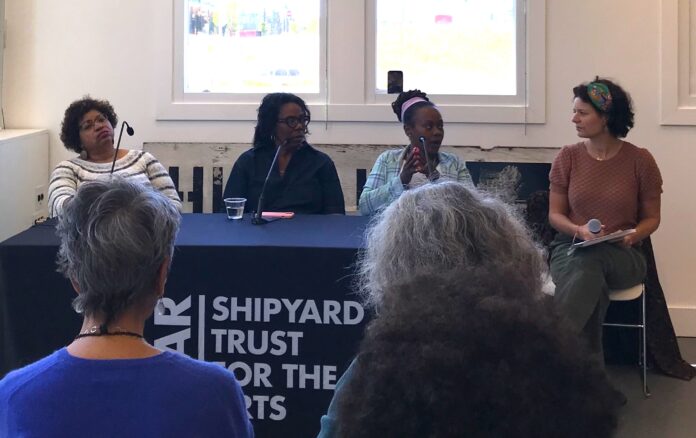Their grandfathers all came to the Shipyard around 1943, pushed out by Jim Crow in the South and pulled in by the promise of a brighter future out West. April Spears’ grandfather from Louisiana became a welder; Denise Pate’s from Arkansas became an electrician; and Emily Rogers-Pharr’s grandfather, a sheet-metal worker. “Once the war ended,” Rogers-Pharrs said, “he was one of the first African American men to integrate the union and work on the skyscrapers downtown.”
While the contributions of many migrants into San Francisco has been recognized (think Beats, hippies and techies), the contributions—and sacrifices—of the families of the three San Franciscans sitting before a standing room only crowd last Saturday at the Shipyard Artists Studios event “Holding Ground: Memory, Resistance, and Black Women’s Voices at the Shipyard” (think jazz in the Fillmore and victory in WWII) have been mostly under-appreciated.
“My grandfather ultimately lost his hearing because of the air hammers they had to use,” Spears said. “That’s why it’s difficult for me to ever give up because I know what my grandfather went through to provide for us. It’s like, ‘How dare you think about giving up?’”
All three women boast impressive resumes of their own: Pate, a local non-profit and executive director with 30 years of local expertise; Rogers-Pharr, Executive Director of the Southeast Community Center and daughter of legendary Bayview community activist Adam Rogers; and Spears, Executive Director of the San Francisco African American Arts District. One day a panel could be organized to honor their accomplishments, but today all three want to stress that they stand on the shoulders of those who came before them.
“Their stories teach resiliency,” Rogers-Pharr said. “Teach you what to brush off your shoulders and what to keep your head high about. They came with nothing and made a community of love and respect.”

What else the welder, electrician and sheet metal worker helped make lined the walls next to the discussion panel. “Decommissioned,” the result of Stacey Carter’s 20-plus years of preserving the history of the Shipyard, is a beguiling and beautiful reveal of the sprawling hub that clattered and clanged with the work of over 18,000 men and women during WWII. (The panel emphasized that women more than held their own at Shipyard. “We have a saying that the mamas, the grandmas and aunties came to do the work,” Rogers-Pharr said. “The men helped open the door.”)
While the Great Migration out West held promise, there was also pain. Jim Crow’s full self might not have walked the streets of San Francisco as brazenly as in Louisiana and Arkansas, but its dark shadow still loomed. “My family was Catholic, and they had gone to Catholic School in Little Rock,” Pate said. “When they came to San Francisco, they tried to go to All Hollows, but were told, ‘We don’t have any room.’ She learned the new racism was they didn’t tell it to your face, ‘No black people.’ They just created obstacles.”
Moderator Julie Zigoris guided the conversation into the years after the Shipyard closed in 1974, when many who had worked there showed signs of illness. “There was a big lump behind my grandfather’s ear,” Spears said. “As a kid, you’re like, what’s that? And then that’s when you start getting the story. He ultimately started having breathing issues, bleeding ulcers and all these different ailments.”
“I remember my grandparents had to come downtown so that they could go, as they said, see about ‘sbestos money,” Rogers-Pharr said. (The panel members laughed, recalling how their southern grandparents dropping the opening “a” in most words.)

“I knew about the Shipyard because we went to church at Our Lady of Lourdes,” Pate said. “They would say that’s the shipyard where grandpa used to work. It was like reverence, because that’s why we have a house.”
To the question of what was the plan after the war ended, Rogers-Pharr said there was no plan. “When the war was over, people were like, now what? And there was just as many people who went back that stayed.” As certain as a bay tide, unemployment swept much of the Black community out of San Francisco or into poverty after the Shipyard closed. Many who hung on were hammered by the ensuing War on Drugs and resulting mass incarceration.
“Piggybacking off of that,” Spears added, “People who stayed were told, by the way, you can’t live in this area. You could have been the Black Pope at that time. You weren’t getting into St Francis Wood.”
The closing remarks about the future of the Shipyard were a mixed bag of confidence and uncertainty. The panel was well aware of the problems that have plagued the clean-up of the Shipyard since it was declared a Superfund site in 1989. And Zigoris noted that current Redevelopment plans include razing almost all of the Shipyard buildings. The three women, patrons of art and culture, rallied around a simple north star for the Shipyard.

“Make it beautiful,” Rogers-Phars says, calling to mind the magic that their relatives brought to the Fillmore to create the Harlem of the West. “And clean it up. And don’t lie about how clean it is.”
“The Shipyard Artists are part of the Shipyard history now,” Pate said. “At the Arts Commission, we fund artists, and one of the challenging things is space for artists to do their work.”
“I think it’s very important that this space is preserved,” Spears said. “Obviously we want it safe, but erasing it and forgetting about it, I can’t allow that to happen.”
Spears noted, to the vigorous agreement of the rest of the panel and a few in the crowd, that not only are most San Francisco visitors completely unaware of the amazing history of the Shipyard, but most San Franciscans are, as well. The Shipyard story needs to be told—and the panel recognizes that history is made by those who get to tell the story.
“We want to be able to tell the story behind these places,” Spears said.





